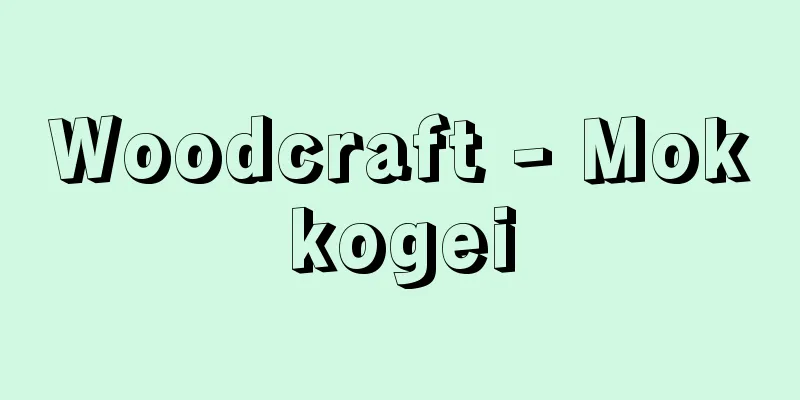Woodcraft - Mokkogei

|
A technique for processing wood artistically, or the product of such a technique. Wooden products include tools and implements, as well as building materials, bridges, wooden fences, palanquins, and boats, but woodcraft primarily refers to the techniques for processing tools and implements. Materials are selected according to the processing method, but the main ones are coniferous cypress, cedar, and pine, and broadleaf trees are paulownia, magnolia, katsura, zelkova, beech, boxwood, walnut, and maple, with high-quality materials such as rosewood, ebony, and black persimmon also being used. [Hirokazu Arakawa] Woodworking TechniquesDepending on the method used to shape the vessels, they can be broadly classified into carved, turned, finger-shaped, and curved. [Hirokazu Arakawa] CarvingThis method involves carving with a sword or chisel, and in the past it was used to shape round objects such as bowls and bowls, but later it came to be used primarily to make parts of utensils such as legs, spouts, handles, and corbels. [Hirokazu Arakawa] TurningA technique for shaping round objects such as bowls, trays, and bowls using a potter's wheel. Wood used is mainly keyaki (zelkova), fir, chestnut, katsura (Japanese zelkova), and tsuba (Japanese bead tree). [Hirokazu Arakawa] JoineryAlso called "itamono" (wooden planks), this is a method of assembling and shaping planks. It is a technique for making various types of boxes, shelves, chests of drawers, and other furnishings, and mainly uses cypress, cedar, paulownia, fir, and keyaki (zelkova). [Hirokazu Arakawa] MagmonoThis technique involves bending thin cypress or cedar boards and attaching a bottom plate to a circular or oval-shaped body, which is then secured with cherry bark. Called "wappa," it is used to make steamers, strainers, sieves, lunch boxes, ladles, charcoal containers, etc. A barrel is made by arranging thin boards of the same width into a circle or oval shape, attaching a bottom plate, and fastening them with a hoop, and is distinguished from bent objects. Decorative techniques for woodcraft include wood painting, wood mother-of-pearl inlay, tortoiseshell pasting, gold and silver painting, color painting, gold leaf pressing, engraving, and lacquering. Wood painting is a method in which thin pieces of wood, bamboo, tusk, horn, etc. are inlaid on the wood base to create geometric or concrete patterns, and thin boards of rosewood, black persimmon, fragrant wood, etc. are cut into square or diamond shapes and attached to the vessel to create geometric patterns. Later wood inlay and marquetry are techniques of this type. Wood mother-of-pearl is a technique in which thick shells cut into patterns are inlaid on rosewood base, etc., and wood inlay using jade, stone, coral, etc. is also of the same type. Tortoiseshell pasting is a decorative method in which tortoiseshell is pasted on the surface or part of an object, while the method of applying colored painting or pressing gold leaf on the back is called under-painting. Gold and silver painting is a technique in which fine powder of gold and silver is dissolved in glue to create a pattern, while the method using pigments is called colored painting. Gold leaf pressing can be used to decorate the surface by pressing gold leaf, or to create a pattern. The technique of creating a pattern is also called foil painting, and there is also a method of using cut foil in square, rectangular, or diamond shapes to create concrete patterns and boundaries. Carving is a method of carving patterns into objects with a sword or chisel, and can be either relief or openwork, and is generally called "horimono" (carved objects). Lacquer painting is a method of applying transparent paint or paint of various colors, but is often treated as a separate technique from woodworking. [Hirokazu Arakawa] History of woodworkingWooden products are prone to decay, and archaeological remains that have been discovered are examples that have been blessed with favorable conditions, so it is not clear how far back the history of woodcraft can be traced. The oldest known examples of wooden products excavated in Japan today are those found at early Jomon ruins in Torihama, Fukui Prefecture, and Kamo, Chiba Prefecture. These include fragments of tray- and dish-shaped wooden vessels, combs, tool handles, paddles, bows, and other items, and it is believed that polished stone axes with double or single edges were mainly used. Many items have been excavated from the late Jomon period, including bows, swords, bowls, and high-rises from the Korekawa ruins in Aomori Prefecture. During the Yayoi period, various stone axes were used, and iron axes and hand axes were also used in some cases. From the middle Yayoi period onwards, woodworking techniques developed, with the use of tools such as axes, hand axes, hatchets, knives, chisels and awls, as well as the use of turntables (a type of potter's wheel) and tenon joints. Unearthed artifacts from the Dainakanokominami site in Omihachiman, Shiga Prefecture, from the middle period, and the Yamaki site in Shizuoka Prefecture, from the later period, are well known, and the high-rise wooden stand unearthed at the Karako site in Nara Prefecture and the Toro site in Shizuoka Prefecture are good examples of the use of a turntable. During the Kofun period, technology was introduced from the continent and showed rapid development. During the Nara period, under the ryo system, the Hakosue no Tsukasa (Cabinet Master) was attached to the Imperial Household Ministry and was responsible for the production of boxes and ceramic tableware. Among the Shosoin treasures, there are many examples that show excellent woodworking techniques and decoration methods, such as the watsumi method, inro aguchi-zukuri, and other unique woodwork constructions. In the Heian period, the Takumi-ryo (Craftsmen's Bureau) was responsible for the manufacture and decoration of furniture, and the trades that belonged to this branch included carpentry, lacquering, woodworking, potter's wheel work, black kudzu work, and willow box work. In addition, handicraft workshops that belonged to the imperial court, the shogunate, shrines, and temples were called saikusho (craftsmen's workshops), and the saikusho workshops directly under the Kamakura shogunate included woodworking, cypress bark work, and others. The Heian period was the heyday of aristocratic culture, when the so-called Japanese style of beauty was established, and refined forms can be seen in the remains of woodworking arts. Furniture in the Kamakura and Muromachi periods basically inherited the forms of the previous era, but there are differences in form and design depending on the era. In the Middle Ages, the za (a za) was a special organization that guaranteed privileges to tradesmen and craftsmen in other trades, but after the Onin War (1467-77), craftsmen who did not belong to this group gradually became active. The Edo Shogunate established a workshop in Nishinomaru and placed the head craftsman in charge of hereditary supplies for various trades. Each feudal domain also employed many craftsmen, due in part to policies encouraging industry. As a result, woodworking was widely practiced during this period and the techniques became highly sophisticated. Many craftsmen who lost their patrons during the Meiji Restoration were forced to change or give up their trade, but the new Meiji government attempted to promote the industry by exhibiting at domestic and international expositions and other means. As a result, woodworking in various regions was revived, and in particular the Edo joinery inlay school and woodworking in Ishikawa Prefecture became very popular. Well-known woodworkers who were active from the end of the Edo period through the Meiji era include Kobayashi Jodei, Kiuchi Kihachi, Kiuchi Hanko, Nishimura Soichiro, Ouki Masasai, Ishikawa Mitsuaki, and Hotta Zuisho. The Bunten Exhibition was held in 1907 (Meiji 40), but the crafts section was not established until 1927 (Showa 2). After the Second World War, the Law for the Protection of Cultural Properties was enacted in 1951 (Showa 26), and based on this law, Kuroda Tatsuaki (1904-82) and Himi Kodō (1906-75) were the first to be recognized as holders of Important Intangible Cultural Properties for "woodcraft" in 1970. Others to be recognized include Ohno Showasai (1912-96), Nakadai Zuishin (1912-2002), Kawakita Ryozō (1934- ), Osaka Hiromichi (1937- ), Nakagawa Kiyotsugu (1942- ), and Murayama Akira (1944- ). [Hirokazu Arakawa] "Encyclopedia of Wood and Bamboo Crafts" edited by Yanagi Sori, Shibuya Sada, and others (1985, Asakura Publishing) [Reference items] | | | | | | |Source: Shogakukan Encyclopedia Nipponica About Encyclopedia Nipponica Information | Legend |
|
木材を用いて工芸的に加工する技法、またはその製品。木製品には器具や道具類のほかに、建築用材、橋梁(きょうりょう)、木柵(もくさく)、輿車(よしゃ)、舟などがあるが、木工芸は主として器具・道具類を加工する技術をさす。材料は加工法によって適材が選ばれるが、針葉樹では檜(ひのき)、杉、松など、広葉樹では桐(きり)、朴(ほお)、桂(かつら)、欅(けやき)、橅(ぶな)、黄楊(つげ)、胡桃(くるみ)、楓(かえで)などがおもなもので、紫檀(したん)、黒檀(こくたん)、黒柿(くろがき)などの高級材なども用いられる。 [荒川浩和] 木工芸の技法器物を成形する方法によって、刳物(くりもの)、挽(ひき)物、指(さし)物、曲(まげ)物に大別される。 [荒川浩和] 刳物刀や鑿(のみ)を用いて削る方法で、古くは椀(わん)や鉢などの丸物の成形も行われたが、のちには脚、注口、把手(とって)、持送りなどの器物の部分をつくるのに主として用いられる。 [荒川浩和] 挽物轆轤(ろくろ)を用いて、椀、盆、鉢などの丸物を成形する技法。おもに欅、樅(もみ)、栃(とち)、桂、橅などを用いる。 [荒川浩和] 指物板(いた)物ともいい、板材を組み立てて成形する方法。各種の箱類、棚、たんすその他の調度類をつくる技法で、檜、杉、桐、樅、欅などをおもに用いる。 [荒川浩和] 曲物檜や杉の薄板を曲げ、円形や楕円(だえん)形の胴部に底板をつける技法で、桜皮で留める。「わっぱ」とよばれ、蒸籠(せいろう)、ざる、篩(ふるい)、弁当箱、柄杓(ひしゃく)、炭櫃(すみびつ)などをつくるのに用いる。桶(おけ)は同一幅の薄板を円形または楕円形に並べ、底板をつけて箍(たが)で締めて成形するもので、曲物とは区別される。 木工芸の加飾法には、木画(もくが)、木地螺鈿(きじらでん)、玳瑁貼(たいまいばり)、金銀絵、彩絵、金箔(きんぱく)押し、刻彫(こくちょう)、漆(うるし)塗りなどがある。木画は、木、竹、牙(きば)、角(つの)などの細片を木地に象眼(ぞうがん)して幾何的模様や具象的模様を表す方法と、紫檀、黒柿、香木などの薄板を方形や菱(ひし)形に切って器物に貼り付けて幾何的模様を表す方法とがある。後世の木(もく)象眼や寄木細工はこの系統の技法である。木地螺鈿は紫檀地などに模様に切った厚貝を象眼する技法で、玉、石、サンゴなどを用いた木象眼も同系である。玳瑁貼は器物の表面または一部に玳瑁(べっこう)を貼る装飾法で、裏に彩絵を施したり金箔を押す方法を伏彩色という。金銀絵は金銀の細粉を膠(にかわ)で溶いて模様を描く技法で、顔料(がんりょう)を用いたものを彩絵という。金箔押しは、表面に金箔を押して飾る場合と、模様を表す方法とがある。模様を表す技法は箔絵ともいい、方形、短冊形、菱形などの切箔を用いて具象文や界線を表す方法もある。刻彫は器物に刀や鑿で模様を彫り表す方法で、浮彫りと透(すかし)彫りがあり、一般に「彫物(ほりもの)」とよばれる。漆塗りは透明塗りや各色の塗りを施す方法であるが、木工芸とは別種の技法として扱われることが多い。 [荒川浩和] 木工芸の歴史木製品は腐食しやすく、発見される考古遺物は好適な条件に恵まれた例であり、木工芸の歴史がどこまでさかのぼるか明らかではない。日本で現在知られている木製品の出土例は、福井県鳥浜や千葉県加茂(かも)の縄文前期の遺跡から発見されたものが古い。盆状や皿状木器の断片、櫛(くし)、道具の柄(え)、櫂(かい)、弓その他があり、主として両刃や片刃の磨製石斧(せきふ)を用いたとみられる。縄文後期になると出土品も多く、なかでも青森県是川(これかわ)遺跡の弓、太刀(たち)、椀、高坏(たかつき)その他が知られている。弥生(やよい)時代には各種石斧を用いるとともに、一部鉄製の斧(おの)や手斧(ちょうな)が併用された。弥生中期以降は木工技術が発達し、斧、手斧、鉈(なた)、刀子(とうす)、鑿、錐(きり)などの工具が用いられ、また回転台(轆轤の系統)の使用や枘(ほぞ)組が行われた。中期の滋賀県近江八幡(おうみはちまん)市の大中の湖南(だいなかのこみなみ)遺跡、後期の静岡県山木遺跡からの出土品が知られ、奈良県唐古(からこ)遺跡や静岡県登呂(とろ)遺跡発見の高坏は回転台使用の好例である。 古墳時代になると大陸の技術が伝来して、技術が急速な発達をみせる。奈良時代には令(りょう)制では筥陶司(はこすえのつかさ)が宮内省に所属し、箱類や陶製食器類製作にあたった。正倉院宝物中には優れた木工技術や加飾法を示す遺例が多く、輪積法や印籠合口造その他の特殊な木地構成がみられる。 平安時代には内匠(たくみ)寮が調度の製作や装飾にあたり、これに属する職種のなかには、細工・漆塗工・木工・轆轤工・黒葛工・柳箱工などがある。また、禁中・幕府・社寺などに属す手工業の工房を細工所といい、鎌倉幕府直属の細工所には木工・檜皮(ひわだ)工その他があった。平安時代は貴族文化の爛熟(らんじゅく)期で、いわゆる和様の美が成立し、木工芸の遺例にも洗練された形態の作がみられる。鎌倉・室町時代の調度類は基本的には前代の形式の継承であるが、形態や意匠には時代による相違が現れる。中世の座は、商工業その他の同業者がその特権を保証された特殊な団体だが、応仁(おうにん)の乱(1467~77)以降はこれに属さない職人が徐々に活躍するようになった。 江戸幕府は西之丸に細工所を置き、細工頭のもとに諸職の世襲用達を管掌させ、各藩も産業奨励の政策もあって多くの工人を抱えた。そのため、この時代には木工芸が広く行われ、技術的にも非常に精巧になった。明治維新によって庇護(ひご)者を失った工人の多くは転業廃業せざるをえなかったが、明治の新政府は内外の博覧会への出品その他によって産業振興を計った。この結果、各地の木工芸も復活し、なかでも江戸指物象眼の系統や、石川県の木工が大いに盛んになった。江戸末期から明治に活躍した木工としては、小林如泥(じょでい)、木内喜八、木内半古(はんこ)、西村荘一郎、仰木(おうき)政斎、石川光明(みつあき)、堀田瑞松(ずいしょう)らが知られている。 1907年(明治40)には文展が開催されたが、工芸部門は1927年(昭和2)にようやく設置された。第二次世界大戦後の1951年(昭和26)には文化財保護法が制定され、それに基づいて1970年に黒田辰秋(たつあき)(1904―82)と氷見晃堂(ひみこうどう)(1906―75)が「木工芸」の重要無形文化財保持者に認定されたのを第1回に、大野昭和斎(しょうわさい)(1912―96)、中台瑞真(ずいしん)(1912―2002)、川北良造(1934― )、大坂弘道(ひろみち)(1937― )、中川清司(きよつぐ)(1942― )、村山明(1944― )が認定されている。 [荒川浩和] 『柳宗理・渋谷貞他編『木竹工芸の事典』(1985・朝倉書店)』 [参照項目] | | | | | | |出典 小学館 日本大百科全書(ニッポニカ)日本大百科全書(ニッポニカ)について 情報 | 凡例 |
<<: Mokkoku (English name) Ternstroemia japonica
>>: Woodworking tool - Mokkougu (English)
Recommend
《Sarvadarśanasaṃgraha》 (English notation) Sarvadarsanasamgraha
…He was a brother of Sayana, a famous commentator...
Walk, walk, walk campaign - Walk, walk, walk campaign
A movement that practices and encourages walking t...
FDM hierarchy - FDM hierarchy
In frequency division multiplexing (FDM), group mo...
Modern-day heroes - Geroy nashego vremeni
A full-length novel by Russian poet and novelist ...
Yoshikawa [Village] - Yoshikawa
A village in Kami County in the central eastern pa...
Huet, B.
…From 1843 onwards, he was an important editor of...
Ancient historical sign - Koshicho
A book of Japanese classics from the late Edo peri...
sheath knife
…Knives as tools are diverse in both function and...
Liver fluke - Licorice fluke
Distoma is the former name for the liver fluke. (M...
Chemnitz
...A city in the state of Saxony in eastern Germa...
Wheeler & Wilson [Company] - Wheeler and Wilson
…In 1851, William O. Grover and William E. Baker ...
Funnel-eared bat
Any mammalian species of the genus Natalus (chirop...
Potatoes
...It is a clay mineral named by Yoshinaga Nagano...
Vogelsberg
...The Middle Mountains region includes the Upper...
Gas alarm - Gas alarm
A device that automatically lights up a danger sig...




![Hakusan [town] - Hakusan](/upload/images/67cc819325a4f.webp)




